 US Navy (1939) – Fleet Aircraft Carrier 1940-42
US Navy (1939) – Fleet Aircraft Carrier 1940-42WW2 US Carriers:
USS Langley | Lexington class | Akron class (airships) | USS Ranger | Yorktown class | USS Wasp | Long Island class CVEs | Bogue class CVE | Independence class CVLs | Essex class CVs | Sangamon class CVEs | Casablanca class CVEs | Commencement Bay class CVEs | Midway class CVAs | Saipan classUSS Wasp (CV-7) was the seventh USN aircraft carrier, sole in her class. The main reason of this was pure, simple mathematics. She was there to “consume” the remaining tonnage of the Washington treaty concerning aircraft carriers. Coming after the excellent Yorktown class, this gave the engineers an occasion to shine by taking the best features of the CV-5 and 6 by then in construction since 1934, but constrained on a limited tonnage, 14,500 rather than 20,000 tonnes. They eventually came out with a mix between the Ranger (CV-4) and the Yorktown, a carrier which was still able to carry 74 aircraft rather than 96 or even 76 as in the Ranger. Since she was alone, like Ranger she served in the Atlantic, before being recalled in June 1942 to the Pacific to compensate for the losses at Coral Sea and Midway. She met her fate during the the invasion of Guadalcanal, torpedoed by a submarine.
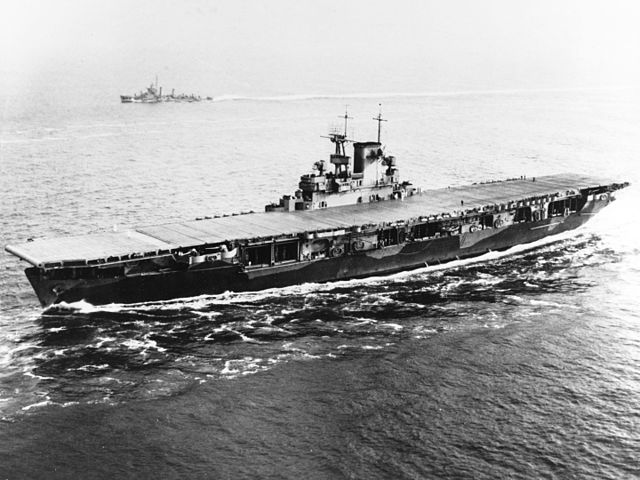
USS Wasp entering Hampton Roads, 26 May 1942
Design development
The Washington treaty CV’s displacement limits
After the tonnage dedicated to the two Lexingtons, this left room for three 23,000 long ton carriers, four 17,250 ton carriers, and five 13,800 ton carriers. Wargames showed severe attrition would favor larger designs, to accomodate as many aircraft as possible. After the Ranger, considered too small, the admiralty decided to “burn” their 23,000 tonnes slots by a remarkable class resulting of these tests: The Yorktown class, designed in 1933-34. By then the idea of a 13,800 tonnes carrier, at first thought like the standard, became an afterthought. There was just enough tonnage left for something in between the 17,250 and 13,800 tonnes range. But the ideas about cramming as many planes as possible in a hull became a challenge for the engineers, and discussions back and forth between BuShips and the admiralty.
Final Design
USS Wasp was the results of the hopes for the USN admiralty to squeeze a large air group onto a 25% lighter vessel than the Yorktown-class. Quite a serious challenge since it called for a reduction of many areas, notably protection, and range. To save weight, and space as well, engineers wanted to give her a low-power propulsion machinery, resulting in an output of 75,000 shp (56,000 kW) compared to Yorktown’s 120,000 shp (or the Essex-class at 150,000 shp !). As a result, she was equipped with a compact British machinery, two Parsons geared steam turbines and six Yarrow boilers. As a result she could reach on paper 29,5 knots (like Ranger), still lass than the 32.5 knots of the Yorktown. The latter, with the Lexingtons, defined the proper speed of a carrier battle fleet and was one reason because both Ranger and Wasp stayed in the Atlantic fleet. The smaller hull meant the ship could carry only 1,600 tonnes of oil, versus at least 2,750 on the Yorktown and up to 4,360 tonnes in fact). But this still granted her a 12,500 nautical miles range, versus 12,000 for the Yorktown, a true tour de force.
Another obvious sacrifice was the absence of armor and no ASW bulges of in-depth underwater defence, making her vulnerable to torpedoes (which proved her downfall). Even the high octane, highly inflammable aviation gasoline tanks were not protected, nor the boiler rooms, or ammunitions stores, even by a stray of armour. These were seen as design flaws only after she was built, forced by the tonnage limit, but in the hope she would be unarmoured in wartime. Another point to explain USS Wasp loss was the relative lack of damage control experience of her team as well.
USS Wasp innovated though, being the first USN (and aircraft carrier at large) ever fitted with a deck-edge elevator. It consisted of a platform for the front wheels and outrigger where its tail wheel went (plus careful handling !). The two sides hydraulic arms moved the platform in a half-circle up and down. This idea was another way to clear the hangar from the space taken by a lift, therefore allowing more planes to be stacked in place. Her crew ballooned from 1,800 when commissioned to 2,100 during wartime.
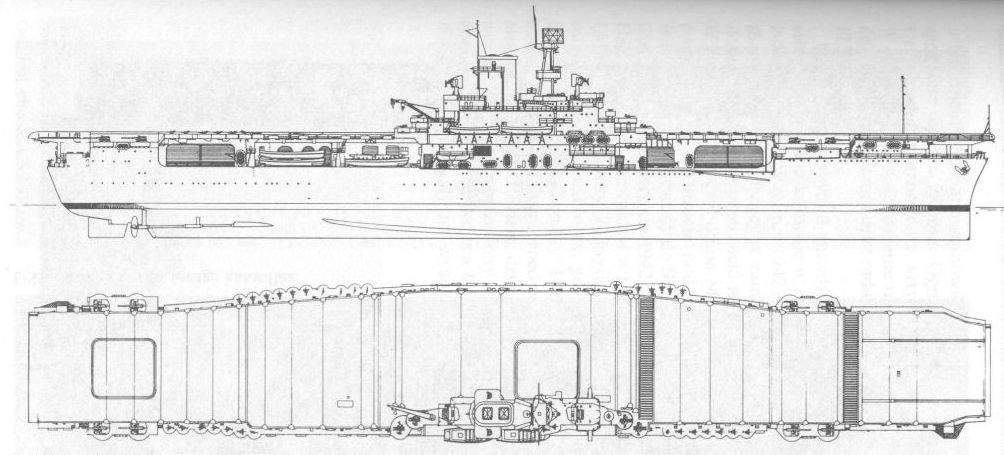
2 technical views of USS Wasp (the blueprints.com)
Dimensions:
As designed, USS Wasp displaced 14,700 long tons (14,900 t) standard, and up to 19,116 long tons (19,423 t) fully loaded. Her length was 688 ft (209.7 m) at the waterline and 741 ft 3 in (225.9 m) overall at flying deck level. Her beam was at 80 ft 9 in (24.6 m) at the waterline and 109 ft (33.2 m) overall at flying deck level. Her draught was 20 ft (6.1 m) deep. Her flight deck was basically a copy of the Yorktown’s but of course shorter compared to the latter, 824 ft 9 in or 251.38 m, so 25 m shorter. Some space was spared by the placement of the lifts. One was aft, on the landing area, below the arrestor cables, of which two had to be let loose to not obstruct the platform. The other was at the foot of the bridge superstructure. The offset lift was located on starboard, facing the forward hangar opening and framed by the two hydraulic arms lifting it to the upper flying deck. It was used with caution, especially in bad weather, but the solution was still in use in the 1950s on Essex carriers. USS Wasp was also equipped with four hydraulic catapults: 2 on the flight deck, 2 on the hangar deck. In 1942 she was given her first and only radar, CXAM-1 for air warning.
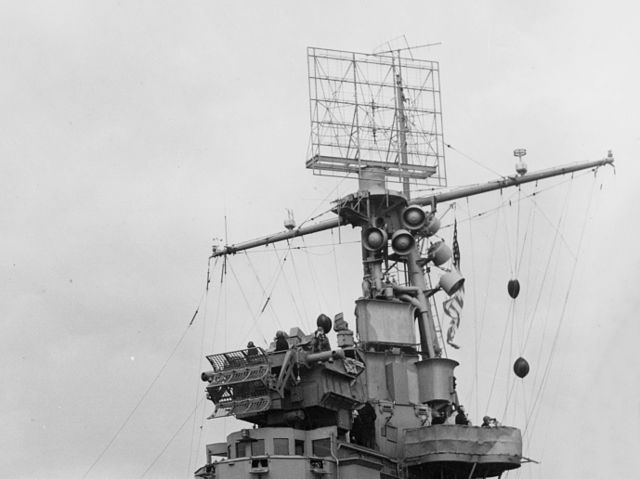
CXAM-1 radar (here on USS Ranger in November 1942)
Propulsion:
A much scaled down version of the Yorktown class to two propeller shafts connected to geared Parsons steam turbines 70,000 shp (52,000 kW) fed by six oil-fired Yarrow water-tube boilers.
Top speed as designed was 29.5 knots (54.6 km/h; 33.9 mph), and her range setup at 12,000 nmi (22,000 km; 14,000 mi) at 15 knots (28 km/h; 17 mph).
Protection:
As seen above it was limited, in the hope in case of war to mount a more substantial protection. The ship’s conning tower had walls 1.5 in (38 mm), the belt was 3.5 in (89 mm) with a backing provision for more, and there was a stray of 1.25 in (32 mm) armored plates on the deck over the steering gear. The flight deck and hangar deck were left unprotected. More problematic that there was no provision made for ASW protection. It was hoped, again, in case of war, to fit bulges in drydock. None of this ever happened and this genera lack of protection directly participated in her fate.
Armament:
CV doctrine progressed much since the 1920s and it was decided to keep the onboard armament of USS Wasp minimal and centered on air threats. It was basically a repeat of the Yorktown’s class armament, but with eight single mount 5 in/38 (127 mm) guns, sixteen 1.1 in (28 mm) AA guns in four quad mounts, the famous “Chicago Piano”, like on USS Yorktown and Enterprise as completed, and twenty-four 0.50 in (12.7 mm) M2HB heavy machine guns, under masks. These were in single mounts. USS Wasp armament stayed “in its juice” when she engaged operations at Guadalcanal. If she had survived, no doubt she would have received not only protection upgrades but a brand new AA comprising 40 mm Bofors and 20 mm Oerlikon guns. The current combination was unsatisfactory. The 5-in/38 were slow, long range weapons only suited to target high altitude bombers, the 1.1 inches (28 mm) lacked punch and were unreliable, and the M2HB too light to “catch” a low flying plane other than by luck. It was not unheard of, as at least one Zero at Pearl Harbor has been claimed shot down by a twin 0.5 cal. mount.
Air group
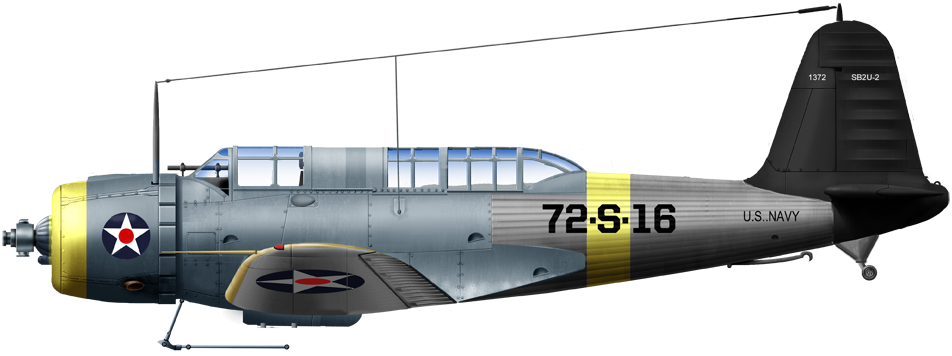
Vought SB2-U of VS-72 onboard USS Wasp upon completion in 1940
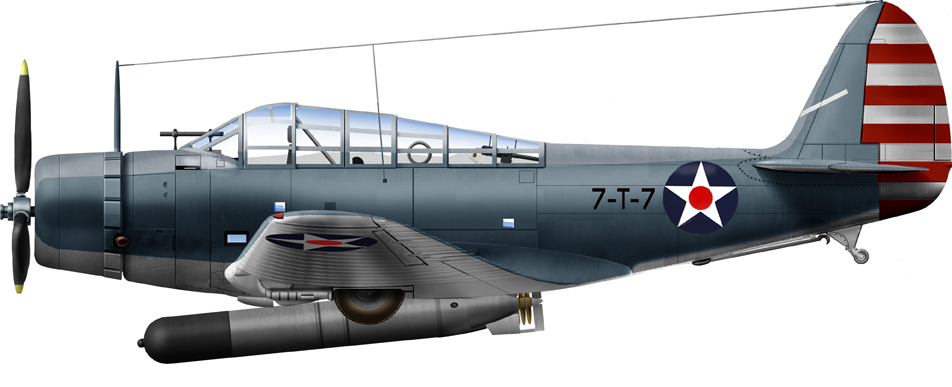
Douglas TBD Devastator onboard USS Wasp in 1942
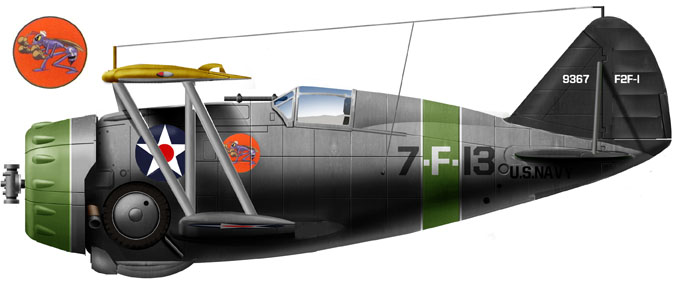
Grumman F3F-1 of VF-7, Neutrality Patrols, USS Wasp, late 1940
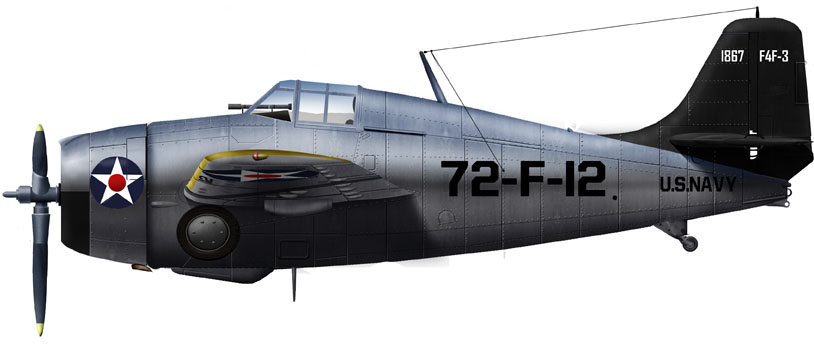
Grumman F4F-3 Wildcat of VF-7, USS Wasp, Late 1942
Although the carrier has been described as capable of carrying up to 100 aircraft, it was only considering her plane carrier role, with her flight deck full, and crated planes below decks. In normal operations, she carried 75 planes at best, and by 1942, more like 65-70 due to new, heavier planes received like the Grumman TBF Avenger. Her initial air group comprised in April 1940
F3F Wildcats fighters from Fighter Squadron 7 (VF-7/73), and scout bombers from Scouting Squadron 72 (VS-72).
VF-72 was created as VF-7 on 1 July 1939, redesignated VF-72 on 19 November 1940, and operating Grumman F2F and Grumman F3F biplane fighters. She never obtained the Brewster F2A and instead went directly to the next Grumman in line, the F4F-3 Wildcat, in December 1940, so soon after entering service. These were deployed as part of Carrier Air Group 7 (CVG-7).
Scout Bombers of VS-72 were presumably Douglas SBU-2 Vindicator. Later in 1941 she obtained a squadron of Douglas TBD Torpedo bombers, replaced in mid-1942 (before her deployment to Guadalcanal) by Grumman TBD Avengers.
Construction
USS Wasp’s keel was laid down on 1 April 1936, at Fore River Shipyard (Quincy, Massachusetts). She was launched on 4 April 1939 at the time, sponsored by Carolyn Edison, wife of Assistant Secretary of the Navy Charles Edison. She was commissioned on 25 April 1940, so one year after, at the Army Quartermaster Base (South Boston, Massachusetts). Captain John W. Reeves, Jr. was her first commander, supervising completion and trials. She was fitted out completely at Boston in May 1940 before sailing on 5 June 1940 for her calibration tests for her radio direction finder. She also received her first air group for mater qualifications.
USS Wasp Specifications as completed |
|
| Dimensions | 690 wl/720 ft oa (210,1/219,45 m) x 81 ft 7 in/100 ft (24.86/30.48 m) x 23 ft 3 in (7 m) |
| Displacement | 14,700 tonnes standard as designed, 18,450 fully loaded |
| Crew | 2,167 |
| Propulsion | 2 shafts Parsons steam turbines, 6 Yarrow boilers, 70,000 shp |
| Speed | 29.5 knots (55 km/h; 34 mph) |
| Range | 12,500 nmi () at 15 knots |
| Armament | 8 × 5 in (127 mm)/38, 4×4 1.1 in, 24 x 0.5 in MGs |
| Aviation | 74 (maximum), 2 elevators, 2 catapults |
| Armor | Belt 0.625 in STS (backing for future increase), Armoured deck 1.25 in (45 cm) |
USS Wasp in action
1940
Back for further fitting out in Boston harbor, USS Wasp sailed again for her first shakedown cruise at Hampton Roads, Virginia, arriving on 24 June. She sailed again on the 28th for the Caribbean, escorted by the destroyer USS Morris conducting her first carrier qualification tests. Lieutenant, junior grade David McCampbell was one of the first of these, later to become the Navy’s top-scoring “ace” during the war (33 victories) compared to Richard Bong (USAFF) and his 40 victories. USS Wasp arrived at Guantanamo Bay Naval Base and was decorated to celebrate Independence Day.
A fatal incident however happened during this shakedown cruiser, on 9 July 1940: One of her Vought SB2U-2 Vindicator dive bombers crashed, some 2 nautical miles from her. She departed Guantanamo Bay on 11 July , back to Hampton Roads and embarked planes from the 1st Marine Air Group, proceeding to their qualification trials. This was done at the southern drill grounds, and it went of for a week before the Marines and their planes landed in Norfolk. USS Wasp by then moved north, to Boston, for her post-shakedown fixes. There, she fired a 21-gun salute to President Franklin Delano Roosevelt, yachting onboard the Potomac at Boston Navy Yard, on 10 August.
The aircraft carrier departed on 21 August for steering drills, full-power trials heading for Norfolk in Virginia. Escorted by the destroyer USS Ellis acting as plane guard, she launched and recovered her aircraft from VF-7 fighter Sqn, VS-72 scout bombers (devastator). She was back in Norfolk Navy Yard on 28 August for repairing her troublesome turbines, staying in dockyard until September, and fully drydocked until September, before making her final sea trials in Hampton Roads, 26 September 1940. By that time she had been in commission already since April.
Now ready for fleet operations, she was assigned to Carrier Division 3 (Patrol Force) from Naval Operating Base, Norfolk. She arrived at Norfolk Navy Yard on 11 October to load 24 USAAC Curtis P-40 fighters (8th Pursuit Group) plus nine North American O-47A reconnaissance aircraft (2d Observation Squadron) spares, personel, and an utility unit with Grumman J2F Duck flying boats before Proceeding to sea, and at destination flew off these planes in a test to compare take-off runs. It was indeed the first time that Army planes flown from a Navy carrier, so to prove a carrier can be used as plane ferry during wartime. This was a role she performed time and again, despite her shorter flight deck compared to the yorktown’s.
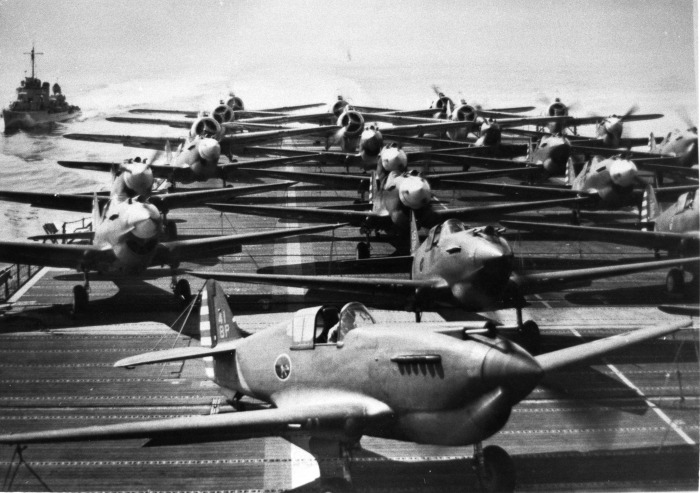
P-40Bs aboard Wasp in October 1940
Wasp sailed for Cuba with her escorts, USS Plunkett and Niblack and during four days, made routine training flights wit her air group, notably dive-bombing. She made a gun salute at Guantanamo Bay Naval Base to Rear Admiral Hayne Elli (Atlantic Squadron Crd) on USS Texas, on 19 October 1940. She stays there until November, pilots earning carrier qualification, gunners practicing short-range fire on towed targets (by the fleet tug USS Seminole). She departed for Norfolk, arriving there on 26 November, and spending Christmas here and conducting degaussing experiments with the survey ship Hannibal.

Wasp on 27 December 1940
1941
USS Wasp was back in Guantanamo Bay on 27 January 1941 for flight operations training into February, escorted by USS Walke, also her plane guard. She trained off Guantanamo and Culebra with USS Texas and the otger aicraft carrier USS Ranger plus the heavy cruisers Tuscaloosa, Wichita, and their destroyers. Training went on until March including on 4/5 March, night battle practice. She met heavy weather while underway to Norfolk on 7 March, steaming at 17 knots (20 mph; 31 km/h). She spotted Off Cape Hatteras about midnight, after flares were fired, the lumber schooner George E. Klinck in disarray. She manoeuvered in a state 7 sea cose to the steamer on 8 March, saving the crew of eight. She proceeded next to Norfolk Navy Yard for turbines fixes and and her third deck portholes were welded over for watertight integrity. She also received steel splinter shielding around her 5 in (130 mm) guns and quad “chicago piano” as well. batteries was added. Her first radar, the RCA CXAM-1 was installed as well. She departed for the Virgin Islands on 22 March, reached St. Thomas and next proceeded to Guantanamo Bay, loading maritime supplies bound to Norfolk. She arrived there on 30 March, and resumed routine flight operations off Hampton Roads.
On 8 April with USS Sampson, she conducted a search for a downed patrol plan, later aborted and until the end of the month, she trained and cruised along the East Coast (Newport-Rhode Island-Norfolk), alternated with patrols with her air group. By May, 12th she dropped anchor at Grassy Bay, Bermuda. She then sailed with USS Quincy and USS Livermore and Kearny for some exercizes and on 3 June was in Grassy Bay before heding for Norfolk with USS Edison. She was back to Bermuda on 20 June, patrolling the area up to Hampton Roads. This went on until 5 July, with the Atlantic Fleet’s neutrality patrol, later extended eastward. She was back in Norfolk on 13 July with USS Tuscaloosa and three destroyers, preparing for her first offensive mission, even if the US were not at war yet.
Occupation of Iceland
After a refresher training off the Virginia Capes, the USN grew more active in the Battle of the Atlantic, with more and more incidents with German U-Boats. To protect American security, and also to free British forces needed elsewhere, the president decided to send troops to occupy Iceland, already under British control. The task force was centered around USS Wasp. Late afternoon July 23th, 32 Army Air Forces (AAF) pilots reported on board “for temporary duty”. The following day their planes were loaded on board: Thorty P-40Cs, three PT-17 trainers (AAF 33rd Pursuit Squadron, 8th Air Group from Mitchel Field, New York). Four newspaper correspondents also came on board to report on this operation. For a refresher, the invasion of Iceland, a territory in principle related to Norway’s royalty (now under German control) could have been a precious advanced based both for the Luftwaffe and U-Boats, threatening the north atantic convoys. On 10 May 1940, the British landed 746 Royal Marines, carried and covered by 4 warships. Despite the government of Iceland issued a protest because of her neutrality but the occupation was swift and peaceful. Now these precious troops were badly needed elsewhere.
USS Wasp ferried these fighters to provide a cover for incoming long range Luftwaffe planes such as the Fw200 condor and German flying boats. They also could provide a cover to watch over the initial American occupying forces. The carrier departed on 28 July with USS O’Brien and Walke and the cruiser USS Vincennes later. They fusioned with Task Force 16 (USS Mississippi, Quincy, Wichita, five destroyers an the auxiliary vessel USS Semmes, attack transport USS American Legion, store ship USS Mizar, amphibious cargo ship USS Almaack). On 6 August, USS Wasp escorted by Vincennes, Walke, and O’Brien departed TF 16 and ionce in the wind, VC-7 started launching the 33rd Pursuit P-40s. They landed in Iceland and the aicraft carrier folded down for Norfolk, arriving on 14 August.
Neutrality Patrols (August-December 1941)
USS Wasp was at sea again on 22 August for more carrier qualifications and landings off the Virginia capes and two days later, Rear Admiral H. Kent Hewitt (Cruisers Sqn, Atlantic Fleet) carried his marke from the USS Savannah to Wasp while in Hampton Roads. She became flagship of the atlantic fleet cruisers and on the 25th with Savannah and the destroyers Monssen and Kearny, she conducted flight operations, notably later in search of the German heavy cruiser Admiral Hipper recently reportedly. On the 30, HMS Rodney was sighted 20 nautical miles (37 km; 23 mi) away, presumably also in search of a German raider, but they did not make contact. Wasp dropped anchored later in the Gulf of Paria, Trinidad, on 2 September. Admiral Hewitt tranferred his flag back to Savannah and CV-7 later resumed her patrol duties. She was signalled a German U-boat closed to the DD USS Greer. USS wasp air group helped patrolling beyond a point halfway across the Atlantic, “mid-ocean meeting point” (MOMP), where British escort took up.
USS Wasp was back to Bermuda on 18 September, and she sailed for the colder waters of Newfoundland, arriving in Placentia Bay on 22 September. After refulling from the oiler Salinas she sailed on 23 September for Iceland with USS Wichita, four destroyers and the repair ship Vulcan. She dropped anchor at Hvalfjörður (Iceland) on 28 September, given more offensive orders by Admiral Harold R. Stark, Chief of Naval Operations.
USS Wasp was back at sea on 6 October with USS Vincennes and four destroyers to patrol the difficult North Atlantic where visibility was poor, the air group often grounded by the fog and heavy weather. She was back to Placentia Bay on 11 October just as a fierce gale erupted. On 17 October she sailed to Norfolk for a refit, and headed for for Bermuda, training en route. She arrived in Grassy Bay on 1 Novembe and patrolled the Bermuda area while the Atlantic saw the USN in practice at war wth Germany after the torpedoing of the USS Kearny and Reuben James and tension building also in the Pacific. CV-7 was back at sea on 3 December, meeting the DD USS Wilson acting as plane guard. Her air group performed night and day exercizes, and gunnery drills. On 7 December 1941 she was back in Grassy Bay when new of Pearl Harbor came.
Atlantic Fleet (Dec 41 – May 1942)
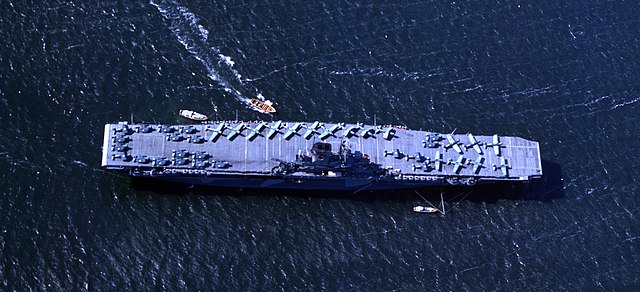
USS Wasp at anchor in Casco Bay, Maine, showing its SBU Vindicator on deck.
The USN admiralty was given a warning -long after the fall of France and Operation Catapult- that French warships refugees in the Caribbean and West Indies could make a breakout, attempting to get back to Vichy France. USS Wasp, escorted by USS Brooklyn, and destroyers Sterett and Wilson was ordered to head for Martinique (French Carribean) while a wrong intelligence report signalled the Vichy French APC Barfleur already at sea. And she was to be sunk or captured unless force to internment again. In reality she was still in harbor, and later the crisis abated as it was realized the interned ships were not a threat.
USS Wasp sailed to Hampton Roads just before Christmas with the escort carrier USS Long Island, and two DDs. She was in Norfolk Navy Yard two days later for a drydock maintenance, and crew leave. Out of it on 14 January 1942, she headed north, off Newfoundland and Casco Bay (Maine) and from 16 March joined Task Group 22.6 (TG 22.6), back south to Norfolk. During the morning watch on the next day, visibility fell to a very low degree and at 06:50 she rammed USS Stack on her starboard. The destroyer had her flak ripped deep, and her first boiler room flooded completely. She was nevertheless able to proceed to Philadelphia Navy Yard for repairs.
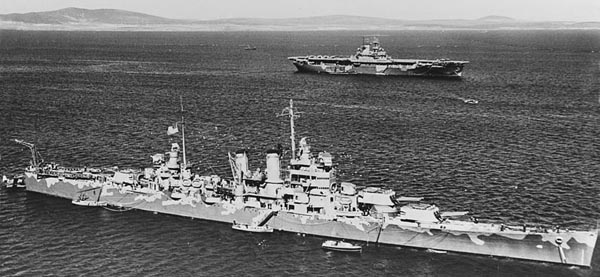
Wasp and the heavy cruiser Wichita in Scapa Flow, April 1942.
USS Wasp was back at Norfolk on January 21, to be back at Casco Bay three days later and then heading for British waters 26 March. She was part of Task Force 39 (Rear Admiral John W. Wilcox, Jr.) which raised his mark on USS Washington. The goal was to reinforce the Home Fleet for convoy escorts against an agressive and still string Kriegsmarine. Rear Admiral Wilcox however was swept overboard on the early morning of 27 March, drowned. Four SB2U Vindicators from USS Wasp took part in the search, one crashing while landing back. Wilcox body was eventually spotted one hour later in the raging seas but not recovered due to heavy weather.
Rear Admiral Robert C. Giffen, took command and raised his flag on USS Wichita. On 3 April they met a Brituish force led by HMS Edinburgh, which escorted them to Scapa Flow. This gave to occasion for Captain Henry Fancourt, Royal Navy, to make the first British landing on an American aircraft carrier with his Gloster Gladiator.
TF 39 integrated the Home Fleet and became TF 99, starting the dagnerous trips to North Russia (Musrmansk convoys). USS Wasp sailed out on 9 April, bound for the Clyde, and Greenock, Scotland. She passed the John Brown Clydebank shipyard, and was fested en route by workers there. USS Wasp indeed was to lead an equally dangerous mission, not to the cold waters of Russia but the warmer waters of Malta. She was to transport reinforcement planes there, to try to re-establish air superiority. This was “Operation Calendar”.
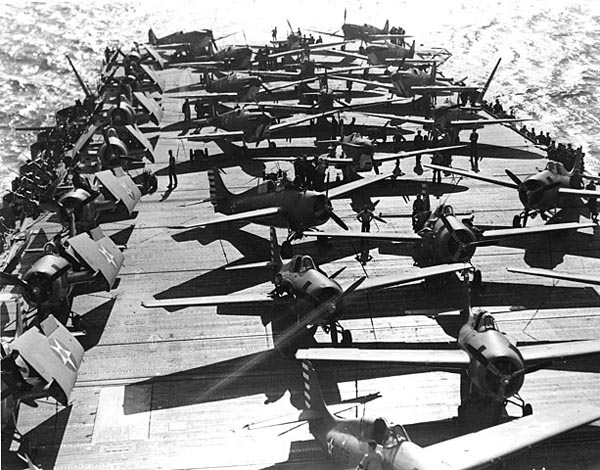
Spitfires and Wildcats aboard Wasp on 19 April 1942.
Fot this mission she landed her torpedo and dive bombers at Hatston (Orkney), to load in exchange 47 Supermarine Spitfire Mk. V fighters (No. 603 Sqn), at Glasgow on 13 April. She departed the following day, protected by Force “W” (battlecruiser HMS Renown, AA cruisers HMS Cairo and Charybdis) plus VC-7 own destroyers, USS Madison and Lang. They passe Gibraltar in darkness on 19 April and at 04:00, 20 April, she launched 11 Grumman F4F Wildcat fighters to form a combat air patrol (CAP), protecting Force “W”. Spitfires were prepared soon, warming up their engines in the hangar below and brought up by elevator to the flight dekc, being given take off go-ahead. They flew towards Malta. Once done, USS Wasp and its escort went back to Gibraltar. The mission success was foiled however as soon as the axis knew about them. They launched a massive air raid and bombed the squadron, just arrived. This was much needed as only three Gladiators and a handful of Hurricanes defended the island.
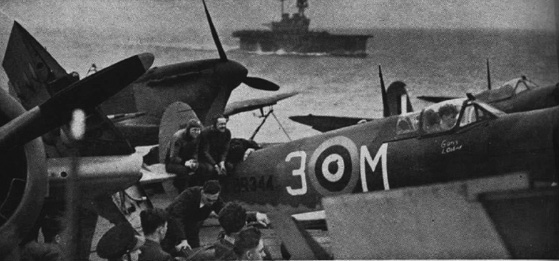
HMS Eagle accompanies Wasp on her second voyage to Malta
Soon, the Admiralty decided for a second ferry run to Malta, under the insistence of Prime Minister Winston Churchill. He asked President Roosevelt to request Wasp again, and it was granted. She would load Spitfire Vs in Glasgow and was back to the Mediterranean on 3 May, accompanied by the carrier HMS Eagle, which also carried a load of Spitfires, loaded at Greenock. This was Operation Bowery.
The two carriers, with the same escort, arrived at their launching points on Saturday 9 May at noon. USS Wasp was ahead of Eagle from around 1,000 yards (910 m) and start launching at 06:30 her VF-71 wildcats for the CAP and afterwards her 17 Spitfires, in two waves, and 47 more. The first however (Sergeant-Pilot Herrington) lost power and plunged under and later Pilot Officer Jerrold Alpine Smith relized his auxiliary tank did not worked and he had not enough gasoline to reach Malta. He chose to fly back and attempt a landing, which succeed at 07:43. VC-7 then headed back to the British waters, while her staff was astonished to hear a German radio station broadcast relating her loss. This led to a humorous anecdote, on 11 May when PM Churchill sent to Wasp the following: “Many thanks to you all for the timely help. Who said a wasp couldn’t sting twice?”
Pacific

USS Wasp entering Hampton Roads, 26 May 1942, back from the med.
Early in May 1942, the Battle of the Coral Sea was succeeded soon by the decisive Battle of Midway, but these left the USN CV in the pacific down to three vessels, so admiral king decided to transfer USS Wasp. She hurried back to U.S. waters for maintenance, fixes and modifications at Norfolk NyD. Her Captain, Reeves was promoted to flag rank and relieved by Captain Forrest P. Sherman (yes, this one) in the meantime, on 31 May. On 6 June, USS Wasp left Norfolk and joined the center of TF 37, escorted by USS North Carolina, Quincy, San Juan and six destroyers. They transited via Panama on 10 June and the unit became TF 18, under command of Rear Admiral Leigh Noyes. This force arrived in San Diego on 19 June and USS Wasp embarked her last load of planes, the most welcomed Grumman TBF-1 Avengers, plus Douglas SBD-3 Dauntlesses replacing the Devastators and Vindicators respectively. On 1 July, this force sailed to the Tonga Islands, escorted troopships carrying the 2nd Marine Regiment. Preparations were made for the invasion of the Solomon Islands, the first major offensive of the pacific, and even first major amphibious operation of US Forces since the start of the war (next would be Operation Torch in North Africa, covered by USS Ranger).
On 4 July, Independence Day, USS Wasp received news that the Japanese just landed on Guadalcanal and prepared to operate land-based aircraft in the region. This was a threat for the New Hebrides and New Caledonia well. The goal was now to rush Marines to capture the airfield before it becomes operational. Vice Admiral Robert L. Ghormley took command of the operation, establishing his headquarters at Auckland, New Zealand. Preparations were made with secrecy and speed and Wasp joined USS Saratoga and Enterprise, making Vice Admiral Frank Jack Fletcher’s Support Force, under tactical overall command of Rear Admiral Noyes, on Wasp.
Guadalcanal Campaign
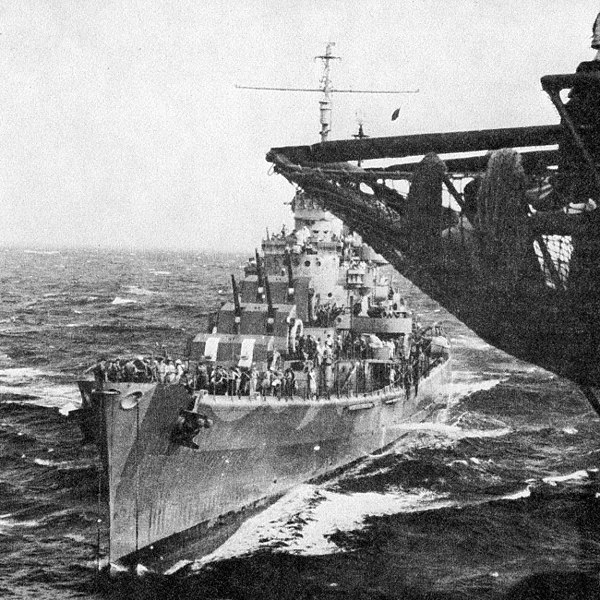
USS Wasp and her air group trained intensively, including for night operations, Captain Sherman being confident his airmen would perform well. The Operation was to start on 1st August, the some of the troopships were late and it was pushed back to a full week, on 7 August. However in the meantime, again, USS Wasp experience turbines problems, reporting a casualty from a burst of her highly vibrating starboard high-pressure turbine. She was limited to 15 knots, uing only her port engine. The vice admiral now waited for a favorable wind. Meawnhile, her crew performed repairs, and for this lifted the entire turbine casing. The tubine rotor was removed and and deposed on the USS BLEACHER anchored in Tongatapu (Tonga)and destroyer tender USS Whitney. There, engineers estimated a four days work, starting on 18 July up to 21 July. USS Wasp made a trial run afterwards, reaching 27 knots. It was recommended to replace all three rows of blading from the rotor after the operation.
USS Wasp was escorted for the mission by heavy cruisers USS San Francisco and Salt Lake City plus four destroyers. They sailed on the evening of 6 August, changed course eastward for a launch position they reached 84 nm (97 mi; 156 km) from Tulagi, arriving just before dawn. Wasp’s CAP was off at 05:57 and soon followed by Dauntlesses, assigned the islands of Tulagi, Gavutu, Tanambogo, Halavo, Port Purvis on Florida Island, Haleta, Bungana and its “Asses’ Ears” radio station. Dauntlesses were escorted by the Wildcats led by Lt. Shands and his wingman S. W. Forrer. They patrolled noth of Gavatu, othered targeted the seaplane facilities at Tanambogo. Surprise was achieved, and the fighter strafed the base, damaging and set on fire patrol planes and fighter-seaplanes there, in total, 15 Kawanishi H8K “Emily” and 7 Nakajima A6M2-N “Rufe” floatplane fighters. Shands himself claimed four “Rufes” and one “Emily”. They also destroyed an aviation fuel truck and another with spare parts. Meawnhile, the Dauntless dive bombers suceeded in blating their objectives.
At 07:04, USS Wasp launched her 12 Avengers, loaded with bombs (Lieutenant H. A. Romberg). They targeted Japanese troop concentrations east of Hill 281 (Makambo-Sasapi sector) Tulagi Island prison, to try to free some prisoners. Soon 10,000 Marines landed, meeting only slight resistance. On Tulagi resistance was greaters and the island was still not in US hands at nightfall. USS Wasp, Saratoga, and Enterprise the retired southward at nightfall.
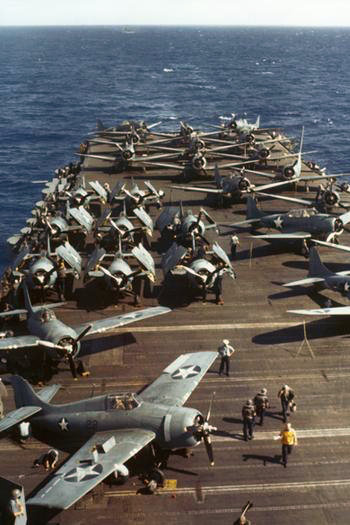
F4Fs launching off Guadalcanal, 7 August 1942.
USS Wasp’s fighters (Lieutenant C. S. Moffett) created the usual CAP the following day when the task force was back to protect the transport area on 8 August. 12 SBD Dauntless (Lieutenant Commander E. M. Snowden) meanwhile took off to search on a 220 nautical miles (250 mi; 410 km) area up to the Santa Isabel Island and New Georgia to try to spot possible Japanese vessels. They patrolled for two hours and only sighted a “Rufe” 40 nm from Rekata Bay, shot down. Japanese planes approaching from Bougainville were signalled, bound to Lunga Point and Rear Admiral Richmond K. Turner ordered the transports toto move out immediately. VS-71 Dauntless meanwhile where operating against Mbangi Island (Tulagi), and the formation was spotted by a rear gunner, which at first assumed they were friendly until starting firing. VS-71 leader, Lt. (junior) Robert L. Howard also attecked G4M “Betty” medium bombers also inbound, shot down an escorting Zero and chased off others. On 7-8 August in total, USS Wasp’s air group had one missing in action (MiA), Ens. Thaddeus J. Capowski, One scout bomber shot down (Lt. Dudley H. Adams, Harry E. Elliott), One fighter crash-landed in the water (pilot recovered), one fighter crashed on deck (injured) and another int the barrier (repaired). Total losses, 3 Wildcat, 1 Dauntless, total claims: 15 flying boats, 8 floatplane fighters, 1 Zero.
On 8 August, Fletcher recommended that the air support was withdrawn, reporting on had 78 fighters left (out of 99) and fuel was running low. Ghormley approved and mission complete, the three CVs retired. Only Gavutu and Tanombogo resisted some more, but on 9 August the Battle of Savo Island saw the sinking of four Allied heavy cruisers, making the Solomons campaign bouncing on the other side. The rest of August was spent in convoys escorts and patrols, until USS Wasp was ordered south by Fletcher to refuel. So she missed the Battle of the Eastern Solomons on 24 August. Refuelled and resupplied on 24 August CV-7 was rushed to the battle zone, with onboard 26 F4Fs, 25 SBDs and 11 TBFs. On 25 August, a search mission started, by SBD Dauntlesses. One, (Lt. Chester V. Zalewski) shot down two Aichi E13A1 “Jake” from IJN Atago, Kondō’s flagship. The Japanese fleet by now had withdrawn, and at 13:26 on 25 August, USS Wasp launched 24 SBD Dauntlesses plus 10 TBF Avengers to try to search and attack Rear Admiral Raizo Tanaka’s convoy bound to Guadalcanal. Apart a flying boat shot down, no ship was spotted. Meawnhile USS Enterprise, damaged had to leave the area for repairs, and USS Saratoga was torpedoed a week later, leaving only two carriers in the southwest Pacific: USS Wasp and the still “green” USS Hornet.
The loss of USS Wasp (15 Sept. 1942)
This Tuesday, 15 September 1942, USS Wasp and Hornet were cruising together, protected by USS North Carolina and 10 other warships, escorting transports (7th Marine Regiment) bound to Guadalcanal. At this point underway, USS Wasp was was 150 nautical miles southeast of San Cristobal Island. Her aircraft were prepared for ASW patrol, whic took off at sunrise and were back at 10:00. A Japanese large flying boat was spotted and downed by one of Wasp’s F4F Wildcats at 12:15. At aroundt 14:20, USS Wasp was turning into the wind for the launch of eight F4Fs and 18 SBDs and recover others from the previous patrol. The recovery of 11 aircraft was done and the ship now veered to starboard, heeling when at 14:44 a lookout reported three torpedoes of the starboard beam.
These were just half of a spread of six Type 95 torpedoes was fired at Wasp from the submarine I-19 (BI type). These torpedoes were an improvement of the already amzaing “long lance” type 93, shorter range (but still three times better thn US ones) and the fastest on record during WW2. Immediately, USS Wasp’s captain ordered hard to starboard but it was too late, due to their speed of 51 knots (94 km/h, 59 mph). Three of them, hit in quick succession at 14:45. One left the water and struck just above the waterline, the other struck close to gasoline tanks and magazines. Two more were sighted ahead of Wasp, passing astern of Helena before striking USS O’Brien while maneuvering. The sixth narrowly missed USS Lansdowne and struck USS North Carolina at 14:52.
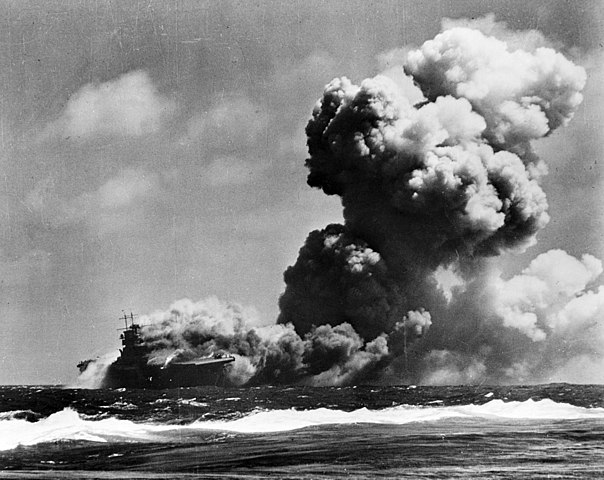
Wasp on fire shortly after being torpedoed.
The forward section of USS Wasp was rocked by the three hits, Aircraft on the flight and hangar decks were thrown away on the other side so violently that their landing gears snapped. The spare aircraft suspended in the hangar overhead fell dow, crushing personal and planes on the deck. Also fuel lines were ruptured and fire broke out in the hangar and below decks. Heated by the furious gasoline fire, ready ammunition in the forward AA guns starboard blew up, shattering all the forward section while one 1.1 in (28 mm) mount was blown overboard in the process. Water lines needed to combat fire on the forward section had been torned off and rendered inoperable, and fires went on, set off ammunition, bombs, and gasoline in a deadly mix of herrific explosions. Since USS Wasp was listing 10–15° to starboard when manoeuvering, oil and gasoline poured in the water, catching fire, making survival for those jumping overboard more difficult.
Captain Sherman ordered to slow down to 10 knots and the rudder turned to port to get the wind, also to keep the fire forward. But soon after the central fire station was also unusable, communication broke internally, while a fierce gasoline fire continue to wreck the forward part of the ship for 24 minutes, added to three additional gasoline explosions. The captain decided eventually to Abandon ship as fire was out of control. Only those would remain behind to combat the fire as much as they could, while the crew was evacuated. The order was confirmed after consultation by Rear Admiral Noye, at 15:20. Badly injured men were given priority, escaping into rafts and rubber boats and the others simply jumped in the water but it still looks for the admiral “orderly”, without panic. Ultimately all the wounded were taken off and the whole process of finding any survivor still inside took 40 minutes. Last to leave were the fire teams. At 16:00 Sherman left the board once communicated there was none left.
Accompanying destroyers supported USS wasp all along, other rushing to chase off the IJN submarine; USS Laffey, Lansdowne, Helena, and Salt Lake City all took onboard the crew, some 1,946 men in all. Given what USS Wasp went though, it was nothing short of remarkable. Still there was a tenuous hope to tow away the CV and save her for the south Pacific Fleet. But four more violent explosions followed at nightfall, and eventually it was estimated even towing the ship was fruitless. USS Lansdowne’s captain was ordered to torpedo the carrier and see her going down. However the first two torpedoes were duds. The captain ordered the next three have their magnetic influence exploders disabled, depth set at 10 feet. They all detonated, but it took until 21:00 for the proud carrier to disappear. 193 men died in the explosions, 366 were wounded, but evacuated. Her 26 airborne aircraft at the time made landed on USS Hornet before she sank, the remainder 45 went down with the ship. IJN I-15 nearby reported the sinking of Wasp, but was soon chased off and depth charged, escaping nevertheless. And so ended the short career of USS Wasp, completed and in service before the third of the Yorktown class, USS Hornet (CV-8).
Between operations, she managed to win five awards and two battle stars: The American Defense Service Medal with “A” Device, the American Campaign Medal, European-African-Middle Eastern Campaign Medal, 1 star Asiatic-Pacific Campaign Medal and 1 star World War II Victory Medal.
Read More/Src
Conway’s all the world’s fighting ships 1922-1947
http://www.navsource.org/archives/02/07.htm
https://en.wikipedia.org/wiki/USS_Wasp_(CV-7)
https://www.history.navy.mil/research/histories/ship-histories/danfs/w/wasp-viii.html
https://www.militaryfactory.com/ships/detail.asp?ship_id=USS-Wasp-CV7
slideshare.net/WKMcIntoshIII/149864116-sternrc2007yorktownclassaircraftcarrierssquadronsignalwarshipsinactionno30?from_action=save
Chesneau, Roger (1998). Aircraft Carriers of the World, 1914 to the Present
Ford, Roger; Gibbons, Tony; Hewson, Rob; Jackson, Bob; Ross, David (2001). The Encyclopedia of Ships.
Friedman, Norman (1983). U.S. Aircraft Carriers: An Illustrated Design History.
Friedman, Norman (2017). Winning a Future War: War Gaming and Victory in the Pacific War.
More photos: https://commons.wikimedia.org/wiki/Category:USS_Wasp_(CV-7)
The modellers’s corner:
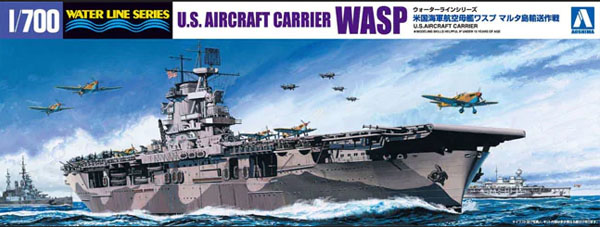
USS Wasp CV-7 Resin Model Kit, Corsair Armada | No. CAP7011 | 1:700
USS Wasp CV-18 – Lindberg | No. 769M | 1:525
Aircraft Carrier USS Wasp CVS-18 Revell | No. 5009 | 1:530
US Navy Aircraft Carrier WASP Aoshima | No. 01034 | 1:700
Five Star 700117 1/700 WWII USS WASP CV-7 1942 Aircraft Carrier Upgrade Set for Aoshima kit
USS Wasp was the 7th USN aircraft carrier, built to use remaining treaty tonnage. She operated in the Atlantic and was sunk at Guadalcanal.

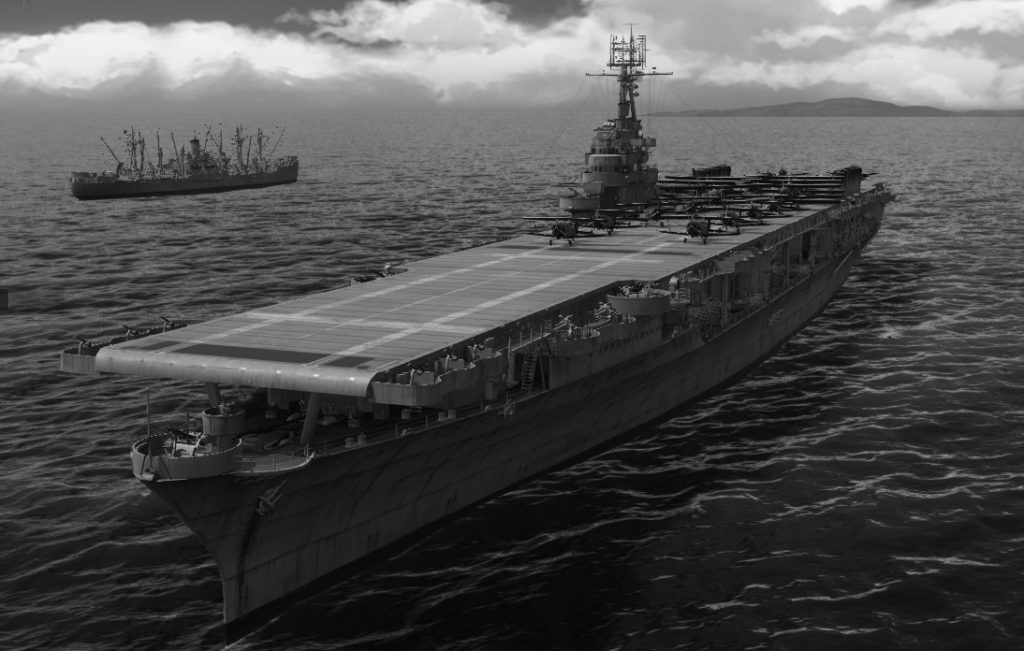
 Latest Facebook Entry -
Latest Facebook Entry -  X(Tweeter) Naval Encyclopedia's deck archive
X(Tweeter) Naval Encyclopedia's deck archive Instagram (@navalencyc)
Instagram (@navalencyc)





 French Navy
French Navy Royal Navy
Royal Navy Russian Navy
Russian Navy Armada Espanola
Armada Espanola Austrian Navy
Austrian Navy K.u.K. Kriegsmarine
K.u.K. Kriegsmarine Dansk Marine
Dansk Marine Nautiko Hellenon
Nautiko Hellenon Koninklije Marine 1870
Koninklije Marine 1870 Marinha do Brasil
Marinha do Brasil Osmanlı Donanması
Osmanlı Donanması Marina Do Peru
Marina Do Peru Marinha do Portugal
Marinha do Portugal Regia Marina 1870
Regia Marina 1870 Nihhon Kaigun 1870
Nihhon Kaigun 1870 Preußische Marine 1870
Preußische Marine 1870 Russkiy Flot 1870
Russkiy Flot 1870 Svenska marinen
Svenska marinen Søværnet
Søværnet Union Navy
Union Navy Confederate Navy
Confederate Navy Armada de Argentina
Armada de Argentina Imperial Chinese Navy
Imperial Chinese Navy Marinha do Portugal
Marinha do Portugal Mexico
Mexico Kaiserliche Marine
Kaiserliche Marine 1898 US Navy
1898 US Navy Sovietskiy Flot
Sovietskiy Flot Royal Canadian Navy
Royal Canadian Navy Royal Australian Navy
Royal Australian Navy RNZN Fleet
RNZN Fleet Chinese Navy 1937
Chinese Navy 1937 Kriegsmarine
Kriegsmarine Chilean Navy
Chilean Navy Danish Navy
Danish Navy Finnish Navy
Finnish Navy Hellenic Navy
Hellenic Navy Polish Navy
Polish Navy Romanian Navy
Romanian Navy Turkish Navy
Turkish Navy Royal Yugoslav Navy
Royal Yugoslav Navy Royal Thai Navy
Royal Thai Navy Minor Navies
Minor Navies Albania
Albania Austria
Austria Belgium
Belgium Columbia
Columbia Costa Rica
Costa Rica Cuba
Cuba Czechoslovakia
Czechoslovakia Dominican Republic
Dominican Republic Haiti
Haiti Hungary
Hungary Honduras
Honduras Estonia
Estonia Iceland
Iceland Eire
Eire Equador
Equador Iran
Iran Iraq
Iraq Latvia
Latvia Liberia
Liberia Lithuania
Lithuania Mandchukuo
Mandchukuo Morocco
Morocco Nicaragua
Nicaragua Persia
Persia San Salvador
San Salvador Sarawak
Sarawak Uruguay
Uruguay Venezuela
Venezuela Zanzibar
Zanzibar Warsaw Pact Navies
Warsaw Pact Navies Bulgaria
Bulgaria Hungary
Hungary

 Bundesmarine
Bundesmarine Dutch Navy
Dutch Navy Hellenic Navy
Hellenic Navy Marina Militare
Marina Militare Yugoslav Navy
Yugoslav Navy Chinese Navy
Chinese Navy Indian Navy
Indian Navy Indonesian Navy
Indonesian Navy JMSDF
JMSDF North Korean Navy
North Korean Navy Pakistani Navy
Pakistani Navy Philippines Navy
Philippines Navy ROKN
ROKN Rep. of Singapore Navy
Rep. of Singapore Navy Taiwanese Navy
Taiwanese Navy IDF Navy
IDF Navy Saudi Navy
Saudi Navy Royal New Zealand Navy
Royal New Zealand Navy Egyptian Navy
Egyptian Navy South African Navy
South African Navy






























 Ukrainian Navy
Ukrainian Navy dbodesign
dbodesign